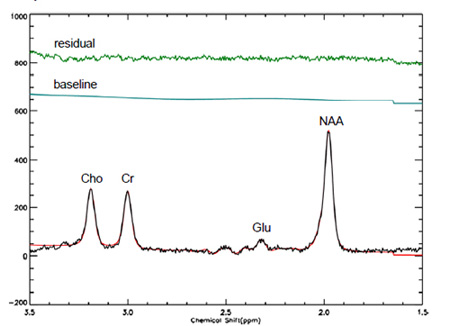Proton Spectroscopy Editing to Measure Glutamate in Human Brain
Glutamate is the major excitatory neurotransmitter in the central nervous system and has an important role in a variety of neurological and psychiatric diseases such as schizophrenia, depression, epilepsy, Alzheimer’s disease, and alcoholism. The detection of glutamate is hampered by entangled coupling and overlapping between glutamate, glutamine (Glx) and N-acetyl-aspartate (NAA). The MRS Core has developed techniques on a GE 3.0T whole body scanner for separating glutamate from Glx and is exploring further improvement. Figure 5 in below is acquired from a normal volunteer in the orbital frontal cortex with the voxel size = 2.0x2.5x3.0 cm3, TR=1.5 s and NEX = 128. With the average echo time technique, other proton signals near the glutamate resonance are well suppressed and the glutamate peak is clearly resolved.

matter region of the human brain. Black: experimental data;
Blue: baseline; Green: residual; Red: fitted spectrum
Reference: John C. Umhau, Reza Momenan, Melanie L. Schwandt, Erick Singley, Mariel Lifshitz, Linda Doty, Lauren J. Adams, Valentina Vengeliene, Rainer Spanagel,, Yan Zhang , Jun Shen, David T. George, Daniel Hommer and Markus Heilig. Acamprosate suppresses magnetic resonance spectroscopy measures of central glutamate in detoxified alcoholics: A randomized controlled experimental medicine study. Arch Gen Psychiatry, 2010;67:1069-1077.

